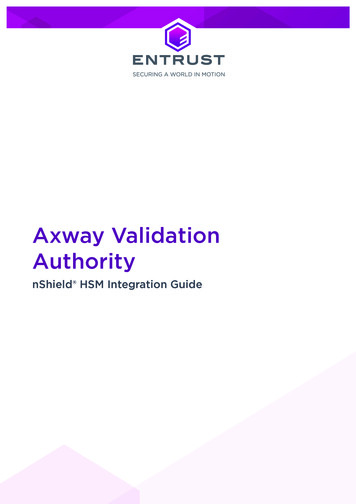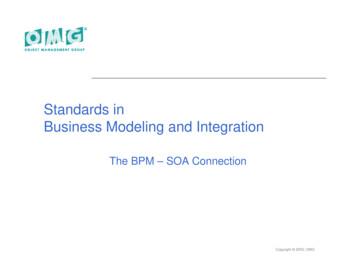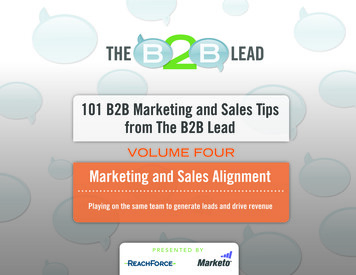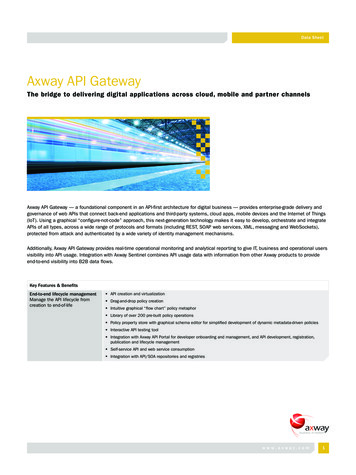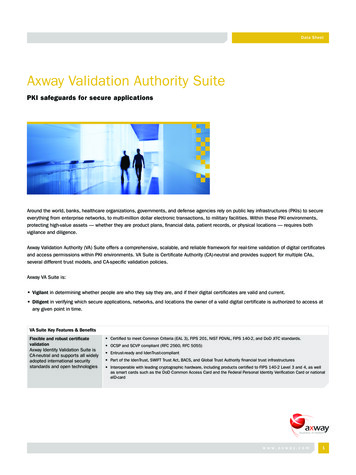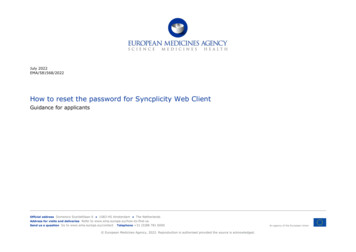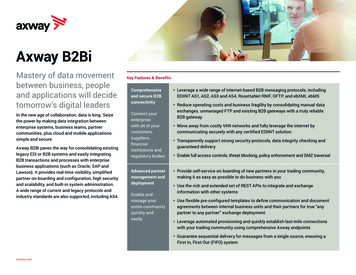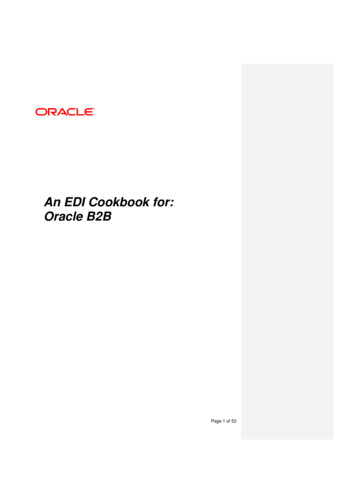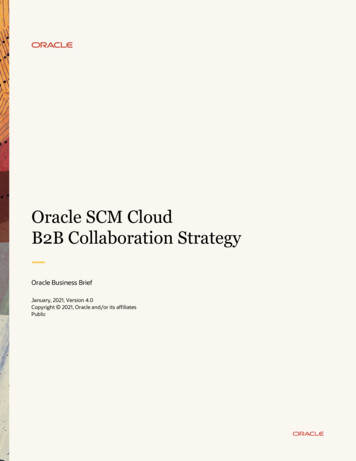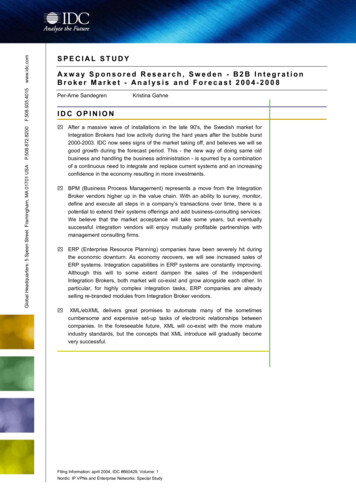
Transcription
www.idc.comF.508.935.4015P.508.872.8200Global Headquarters: 5 Speen Street Framingham, MA 01701 USASPECIAL STUDYAxway Sponsored Research, Sweden - B2B IntegrationBroker Market - Analysis and Forecast 2004-2008Per-Arne SandegrenKristina GahneIDC OPINIONAfter a massive wave of installations in the late 90's, the Swedish market forIntegration Brokers had low activity during the hard years after the bubble burst2000-2003. IDC now sees signs of the market taking off, and believes we will segood growth during the forecast period. This - the new way of doing same oldbusiness and handling the business administration - is spurred by a combinationof a continuous need to integrate and replace current systems and an increasingconfidence in the economy resulting in more investments.BPM (Business Process Management) represents a move from the IntegrationBroker vendors higher up in the value chain. With an ability to survey, monitor,define and execute all steps in a company’s transactions over time, there is apotential to extend their systems offerings and add business-consulting services.We believe that the market acceptance will take some years, but eventuallysuccessful integration vendors will enjoy mutually profitable partnerships withmanagement consulting firms.ERP (Enterprise Resource Planning) companies have been severely hit duringthe economic downturn. As economy recovers, we will see increased sales ofERP systems. Integration capabilities in ERP systems are constantly improving.Although this will to some extent dampen the sales of the independentIntegration Brokers, both market will co-exist and grow alongside each other. Inparticular, for highly complex integration tasks, ERP companies are alreadyselling re-branded modules from Integration Broker vendors.XML/ebXML delivers great promises to automate many of the sometimescumbersome and expensive set-up tasks of electronic relationships betweencompanies. In the foreseeable future, XML will co-exist with the more matureindustry standards, but the concepts that XML introduce will gradually becomevery successful.Filing Information: april 2004, IDC #660429, Volume: 1Nordic: IP VPNs and Enterprise Networks: Special Study
TABLE OF CONTENTSPIn This Study1Methodology . 1M a r k e t O ve r vi ew2Background . 2The Standards . 2Topology. 2Trends . 3XML . 3Business Process Modeling - BPM. 4And the winner is? . 5Vendor Profiles . 6GENERALISTS . 8Ascential Software Corporation . 8BEA Systems . 8IBM . 9Microsoft. 10Sonic Software (part of Progress Software) . 10SPECIALISTS . 11Axway. 11Icore Solutions. 12Inobiz. 12SeeBeyond. 13Seeburger. 13Sterling Commerce (part of SBC). 14TIBCO . 14webMethods . 15Xware . 16Market Value and Future Outlook17Market Shares, Value and Forecast . 17Definition of the Market. 17Market Value . 17Market Positioning Grid . 20Ap p e n d i x22Methodology for the Market Positioning Grid. 22Forecast Assumption Table . 23#660429 2004 IDC
LIST OF TABLESP1Overview B2B Integration Broker Vendors in Sweden . 72B2B Integration Brokers, Sweden, Number of Installations. 183Market Value and Forecast, Swedish B2B Integration Brokers, MSEK. 1842003 Value of New Sales, Largest Vendors Swedish B2B Integration Broker market(MUSD) . 195Key Forecast Assumptions for the Swedish B2B Integration Broker market development2004-2008 . 23 2004 IDC#660429
LIST OF FIGURESP1All-to-All vs. Star Topology . 32Market Shares, B2B Integration Broker Sales 2003. 193Market Positioning Grid, B2B Integration Broker Vendors on the Swedish Market . 20#660429 2004 IDC
IN THIS STUDYThis is a client-sponsored research by Axway Nordic.The study describes vendors in the Swedish B2B Integration Broker market 2003 andprovides vendor profiles with installed base and clients, and a future outlook in form offorecasts of market growth 2004/05, and a forecast 2004-08 on numbers of soldlicenses.The included vendors are chosen by Axway, together representing the essentialplayers in this field on the Swedish market. The study also presents a marketpositioning grid, based on the definitions and limitations mentioned above, and showsIDC's view of the current market dominance of the vendors and the ability of thevendors to increase their share of the market.The Market for B2B Integration Brokers, as we look upon it in this study, is defined inthe following Market Overview sections including the above limitations. This is achanging market where standards and technologies are in constant development.The purpose of this study is to provide a better understanding of the Swedish marketsituation as of today, and also give IDC's view of the forthcoming marketdevelopment.MethodologyThe qualitative and quantitative findings of this report are based on an eclecticresearch approach that combines both primary and secondary research.The main primary sources are interviews with the vendors included in this report.Secondary sources include public information, which has provided valuableinformation both on specific vendor performances and on general development of themarket, and the whole economy. The main media have been the Internet, pressreleases, news articles, financial reports and the press.IDC's previous studies on the e-Business, enterprise application integration marketsand Web Services have served as baseline information. 2004 IDC#6604291
MARKET OVERVIEWBackgroundThe StandardsThe history of business electronic information exchange dates back to the days whenbusiness information first was stored on computers. Early electronic interchange usedproprietary formats agreed upon between two trading partners requiring newprograms each time a new partner was added to the existing system.Realizing the savings in time and administration, the idea of standardized EDI(Electronic Data Interchange) soon arose. In the 70's some industry groups began acooperative efforts to develop industry EDI standards for purchasing, transportation,and financial applications. Many of these standards supported only intra-industrytrading, which led to a large number of EDI formats.In 1979, the Accredited Standards Committee (ASC) X12 was formed to develop ageneric EDI standard. In 1993, it contained 192 standards. In the U.S., the mostcommonly used standard became X12, coordinated by the American NationalStandards Institute (ANSI). In Europe, it is the Electronic Data Interchange forAdministration, Commerce, and Transportation (EDIFACT) standard by UN/ECE(United Nations/European Commission of Europe).TopologyWith standards, such as EDIFACT, gaining ground, more and more nodes could beadded to the EDI network. It was soon realized that in a complex environmentemploying many applications that the administrative effort in keeping all applicationsand nodes updated grew larger and larger. In a all-to-all environment, every possibleconnected application had to be informed and updated about a change made to anysingle node.The need for a central node in a star topology became evident with its potential todrastically reduce the task of updating and keeping all connected applications up-todate. This led in the early 90's to the birth of the Message Brokers, collecting amajority of administrative tasks to a single point.2#660429 2004 IDC
FIGURE 1All-to-All vs. Star TopologySource: IDC, 2004The potential savings that can be made is witnessed in many customer cases allaround the world. Apart from the obvious benefits when it comes to updating andsupport of the network several other benefits can be achieved depending on thesystems characteristics prior to the implementation of a Message Broker system. Themain benefits include:Faster service to business partnersReduced support for updating/maintenanceSpeed up of internal processesReduced down-timeReduced development timeReduced infrastructure costTrendsXMLIn September 1999 CEFACT (United Nations Centre for Trade Facilitation andElectronic Business) launched an international initiative to develop an open XMLbased framework, enabling the global use of electronic business information, in aconsistent, interoperable, and secure manner. The purpose was to create a GlobalRepository for the translation of XML tags in UN/EDIFACT, to advance the use of EDIover the Internet. The repository is a location where shared Internet directories arestored and where users can manually or automatically look up the meaning anddefinition of XML/EDI Tags.XML stands for EXtensible Markup Language and is a subset of SGML (StandardizedGeneral Markup Language), which is also the origin of HTML. The combination ofXML and EDI semantic foundations, called XML/EDI, provides a complete andinternet-friendly framework and creates a format that is usable by applications as wellas humans (through a browser). 2004 IDC#6604293
The initiative, which was subsequently named ebXML, was undertaken in conjunctionwith the Organization for the Advancement of Structured Information Standards.(OASIS).Today, ebXML is a suite of specifications that enables enterprises to conductbusiness over the Internet. With ebXML, companies have a standard method toexchange their business messages, conduct trading relationships, communicate datain common terms and define and register business processes.Backed by UN/CEFACT (one of the four de jure standards bodies in the world) andOASIS, ebXML is already a de-facto standard for electronic commerce over theinternet. RosettaNet, a consortium of more than 400 companies in informationtechnology, electronic components and semiconductor manufacturing, plans tointegrate support for the ebXML Messaging Services Specification in future releasesof RosettaNet's Implementation Framework (RNIF). The Global Commerce Initiative,which represents manufacturers and retailers of consumer goods, chose to base theirnew Internet protocol standard for trading exchanges and B2B communications onebXML.Other industry organizations, such as the Automotive Industry Action Group, HealthLevel Seven, Open Applications Group, Open Travel Alliance, SWIFT and formalinternational and North American EDI standards bodies, have also been activeparticipants in the ebXML initiative.One of ebXML's greatest promise is not only to automate the information exchangebetween companies, but also to automate the often lengthy and costly process ofsetting up the communication channel (an "XML connector"). After initial contactsbetween companies agreeing on doing business, a Company A wishing to dobusiness with Company B can automatically look up Company B's electroniccapabilities in a registry available on the internet. In that registry, Company A will getall details about what XML schemes Company B can handle, what securitymechanism that are at hand, address of its server and much more. A set-upprocedure follows, where automated messages are exchanged configuring andconfirming the connector and its characteristics.As a final note on XML, some issues will have to be dealt with. XML is not a byteeffective format; messages tend to be larger than other existing alternatives. And in afuture where companies' information exchange over the internet is expected to beenormous, size matters. Another issue is security. Although a number of initiativesexists, there is still plenty of work that needs to be done in order to be able to securelytransmit information on public channels.Business Process Management - BPMThe information exchange within different functions in a company is a critical function,which bears the evidence of the company's processes. Add to this an inter-companycommunication system that automatically sends and retrieves information tosuppliers, partners and customers.The vendors of integration systems moves higher up in the value chain when theirproducts maps a company's business processes. This change has been an ongoingprocess and today several vendors offer functionality enabling a graphical top-downapproach that starts with business process mapping and ends with code-generationfor the Message Broker system.4#660429 2004 IDC
Again, the needs for standards in notation became evident and the BPMI (BusinessProcess Management Initiative) was formed in 2000 by a group of IT vendors andManagement Consultants. Today it has 90 members. The communicated mission isto promote and develop the use of Business Process Management (BPM) through theestablishment of standards for process design, deployment, execution, maintenance,and optimization. BPMI.org develops open specifications, assists IT vendors formarketing their implementations, and supports businesses for using BusinessProcess Management technologies. Among the companies reviewed in this documentmembers are: Axway, BEA, IBM, SeeBeyond, Sterling, Tibco and WebMethods.A key result of the initiative is the meta-language BPML (Business Process ModelingLanguage) for the modeling of business processes. BPML provides an abstractedexecution model for collaborative & transactional business processes based on theconcept of a transactional finite-state machine. Whereas XML is a meta-language formodeling of Business Data, BPML models Business Processes.Another component from the initiative is the BPMN (Business Process ModelingNotation), which is the notation standard for business process modeling. The firstversion of BPMN was released in August 2003. By March 2004 BPMN support wasavailable in the following products: aXway Process Manager, ILOG JViews, ITPearlsProcess Modeler for Visio, Popkin’s System Architect, and SeeBeyond’s IntegratedComposite Application Network (ICAN) Suite. Microsoft Visio 2003 also provides aBPMN. IBM plans to release BPMN in coming releases of WebSphere BusinessIntegration Modeler.Going back to the modeling language, BPML, there are at least one competingstandard. Maybe the most significant one was launched by the unlikely alliance ofIBM and Microsoft, plus BEA and SAP and is called BPEL (Business ProcessExecution language), BPEL is an XML-based specification for defining how you cancombine Web-services to implement business processes. BPEL is developed throughthe previously mentioned standardization body OASIS. BPEL builds upon the WebServices Definition Language (WSDL) and XML Schema Definition (XSD) developedby W3C (Worldwide Web Consortium).And the winner is?In the field of integration and eBusiness, standards are numerous and in constantevolution. Some standards arise from de jure standardization bodies, others becomede facto through broad installed basis. Even though open-source/royalty freestandards attract positive attention, in the end the market will decide what becomesthe standard – not standards bodies or consortia. Vendors that choose an agnosticview and closely adapts to the changing standards environment, should be wellpositioned for the future. 2004 IDC#6604295
Vendor ProfilesIDC estimates that the vendors included in this study together represents 95% of thecurrent Swedish B2B Integration Broker market. The remaining market is covered bycompanies such as SAP and Oracle, which include or offer integration brokerfunctionality or modules in their system offerings. The included companies can bedivided into two groups, generalists and specialists. The specialists retrieve almost allof the revenue from the field of Enterprise Application Integration (EAI), whereasmany of the generalists only have a few % or less of their turnover generated fromthis field.Generalists generally offer the Integration Broker functionality as a part of a biggersoftware package that could employ a vast number of tasks. Example of this is IBM'ssuite WebSphere. Ascential is in this sense a smaller generalist than IBM, and theirfocus is on integration software though its successful acquisition of the Mercatormapping tool. Microsoft promotes its BizTalk server, which in turn is what the some ofthe Swedish vendors in this study use as base for their own offerings. Otherspecialists have developed their own platform from the start, e.g. WebMethods, buthave then acquired companies to broaden their portfolio into a more complete suite ofintegration applications. Axway have their product XIB which trace its roots back tothe originally Frontec-developed product AMTrix, through the acquisition of theproduct from Viewlocity. Some vendors started off by successfully providing solutionsin a specific vertical, e.g. Seeburger started by integrating application in the Germancar industry, whereas SeeBeyond begun in the healthcare industry. They have thensuccessfully entered new industries with widened product portfolios.The different origins and focus actually very well pictures what is a fragmented marketin constant development. Some of the vendors are globally recognized with verycapable product portfolios, but can still be very small on a specific market such as theSwedish. Axway is a particularly successful player on the Swedish market, much dueto Frontec's many AMTrix installations in the 90's.For this industry, competition can be found from the ERP companies that constantlyimproves their integration capabilities. Since recently, Seeburgers integration brokercan be found as a re-branded module offered by SAP. Another form of competitioncomes from IT service providers that by-pass a central integration broker solution anddirectly connects applications to each other. We do not measure this market as itdoes not fall under the definition of an Integration Broker. Several of the vendorscovered in this report have sold Integration Broker solutions to IT service providers,such as WM-data or TietoEnator. They in turn, offer B2B functionality in a VANrdservice (Value Added Network) to 3 party customers. In this case, a singleIntegration Broker will handle many customers needs.As a last form of "competition", we note that we've seen an increasing interest fromlarge companies to support their smaller customers and suppliers with their B2Bneeds. In these cases they provide services to their partners via their own B2BIntegration Broker installation.6#660429 2004 IDC
TABLE 1Overview B2B Integration Broker Vendors in SwedenCompanyCountryof OriginGlobalRevenue2003 (Changeover 2002)SwedishRevenue2003(Changeover 2002)Employees/ inSwedenPrimary Integration PlatformSales SplitDirect /PartnerGENERALISTSAscentialUS186 MUSD( 66%)25 MSEK( 50%)639 / 3BEAUS934 MUSD(-4%)( 10%)3173 / 30IBMUS89 131 MUSD( 9%)MicrosoftUS32 187 MUSD( 14%)140 MUSDUS23 MUSD( 54%)( 75%)1 200 / 16France75 MEUR( 7%)4.6 MEUR( 45%)600 / 30Sonic320 000 /4 00055 000 /380DatastageTXAscential EnterpriseIntegration Suite40 / 60BEA WebLogic IntegrationBEA WebLogic EnterprisePlatform90 / 10WebSphere SuiteMicrosoft BizTalk Server10 / 90Commerce ServerSonic ESB (EnterpriseService Bus)50 / 50SPECIALISTSAxwayAxway Integration Broker25/75Axway Integration PlatformIcoreSweden7.4 MSEK(-8%)7.4 MSEK(-8%)8/8iCore Process Server30/70InobizSweden-6 MSEK9/9Inobiz Integration Server5 / 95673 / 6SeeBeyond EAI / ICANSuite100 / 0Seeburger BusinessIntegration Server50 / 50Gentran Integration Suite(US), Sterling Integrator(Europe) ConnectTibco BusinessWorks /Business Connect100 / 0SeeBeyondUS138 MUSD(-9%)( -0%)2 MUSD( 31%)SeeburgerGermany275 MEUR0.4 MEUR350 / 1SterlingUSPart of SBCCommunications264 MUSD(-3%)15.6 MUSD2 000 / 144MUSD895 / 11845 / 6( 25%)TibcoUSWebMethodsUS197 MUS6.5 MUSD(-30%)Sweden( -0%)20 MSEK( -0)Xware20 MSEK( -0%)1575 / 25WebMethods IntegrationPlatform0 / 100XTrade BusinessCommunication Suite0 / 100Source: IDC, 2004 2004 IDC#6604297
GENERALISTSAscential Software CorporationAscential Software Corporation, headquartered in Westborough, Massachusetts, US,since July 2001, provides enterprise data integration solutions. Their offering, theAscential Enterprise Integration Suite, is used by more than 3,000 customers fromdifferent industries, including many industry leaders. Their ambition is to become theleading provider of enterprise integration software. The company also offers a fullrange of consulting, educational and support services. Ascential Software expandstheir product offerings basically through business acquisitions. Their acquisition ofMercator Software complemented their product portfolio specifically and made them asuccessful Integration Broker Vendor. Their product for B2B integration is namedDatastageTX.Started in 1986 they operated under the name of "Informix Corporation''. In early 2001they consolidated their business units into two operating segments: Informix Softwareand Ascential Software. Later the same year the database business assets, includingthe name "Informix'' was sold to IBM. In connection to this they also changed theirname to "Ascential Software Corporation'' (NASDAQ: ASCL), since then their soleoperating segment.Major contributions to the company's technology integration strategy include thefollowing acquisitions: 2003 Mercator Software. In 2002 INTEGRITY data qualitymanagement and cleansing technology from Vality Technology and MetaRecon dataprofiling technology from Metagenix, 2001 Torrent Systems, 2000 Ardent Software,1999 Prism Solutions and in 1998 Dovetail Software.Ascential Software distributes products through four main channels: direct sales enduser licensing, value-added resellers, systems integrators and embedded resellers.IBM, one of their value-added reseller partners, accounted for more than 10% ofrevenues 2002. Another partner is SAP. Principal geographic markets for theirproducts are North America, Europe and the Asia/Pacific region.Total revenues for 2003 were 186 million ( 8%). Ascential Software had a total of639 employees during 2002. Of these 421 were located in the United States.Ascential Software has a regional sales office in Stockholm, Sweden, with 3employees. Their total revenue 2003 was 25 milion SEK, half of which came fromB2B integration. The revenue growth in Sweden has been around 50% during 2003.They have about 25 customers of whom 15 have chosen B2B solutions. Someexamples are Vattenfall, the Post Office Administration, Nordea, Enskilda Securities,OMHEX, SHB, Sydkraft and Arla Foods.BEA SystemsBEA Systems, Inc. was founded in early 1995 by Alfred Chuang, Bill Coleman and EdScott, all three of them coming from Sun Microsystems. The name BEA is composedof the initials of the company's three founders.BEA is one of the worlds leading application infrastructure software companies withmore than 15,000 customers around the world, including the majority of the FortuneGlobal 500. BEA’s products have been adopted in a wide variety of industries. Thecompany is headquartered in San Jose, Calif., and has 93 offices in 34 countries.8#660429 2004 IDC
The BEA WebLogic Enterprise Platform provides the application infrastructurefoundation that converges application development and integration. It is also thestandard for more than 1,600 systems integrators (SIs), independent softwarevendors (ISVs), and application service providers (ASPs) who partner with BEA. TheirB2B IB product is named BEA WebLogic Integration.BEA sells primarily through an enterprise sales force covering geographic territories.An important lead generator is developers’ ability to download a free trial copy ofBEA’s products. BEA employs telesales and geographic sales professionals and sellsthrough or along with indirect channel partners. To broaden its capacity and customercoverage, BEA has formed strategic alliances with many of the world's top SIs, ISVsand hardware OEMs. ISV partners build applications on BEA’s infrastructure, orprovide solutions that complement and complete BEA’s product.Total revenue 2003 US 934 million (-4%), net income 83.9 million. Total number ofemployees worldwide are 3,173.The office in Sweden has 30 employees. They also have partner relationships witharound 30 other companies some of which are Accenture, Cap Gemini, EDS, HP,WM-data, Tieto Enator and Kentor.Customers in Sweden with WebLogic installations are the Social insuranceadministration (RFV), Nordea, Vattenfall, the National Police Office, TeliaSonera,Comhem, the Swedish Television, Apoteksbolaget and The Motor Vehicle Inspection.IBMThe history of the International Business Machines Corporation (IBM), the world'slargest technological company begun in New York in 1911. Nearly all of thecompany's products have since been designed and developed to record, process,communicate, store and retrieve information -- from its first scales, tabulators andclocks to today's powerful computers and vast global networks. The businessnowadays includes computer systems, software, networking systems, storagedevices and microelectronics as well as services and consulting.Organizationally, the company’s major operations comprise a Global Servicessegment; three Hardware product segments (Systems Group, Personal SystemsGroup and Technology Group); a Software segment; and a Global Financingsegment.With some 320,000 employees worldwide and thousands of partners in more than160 countries, IBM made a total revenue 2003 of US 89,131 million ( 9%). Netincome: 7,000 million.IBM’s clients are found in every major industry and the public sector. From soleproprietorships to the world’s largest organizations, governments and companies.Over the last decade, IBM has greatly de-emphasized its involvement in consumermarkets to concentrate on the enterprise market.The WebSphere portfolio is composed of several solutions for e-business eitherdeveloped at IBM on demand or buy acquisition of other software companies.WebSphere includes application servers, development tools, portals, businessintegrati
Process Management Initiative) was formed in 2000 by a group of IT vendors and Management Consultants. Today it has 90 members. The communicated mission is to promote and develop the use of Business Process Management (BPM) through the establishment of standards for process design, deployment, execution, maintenance, and optimization.

